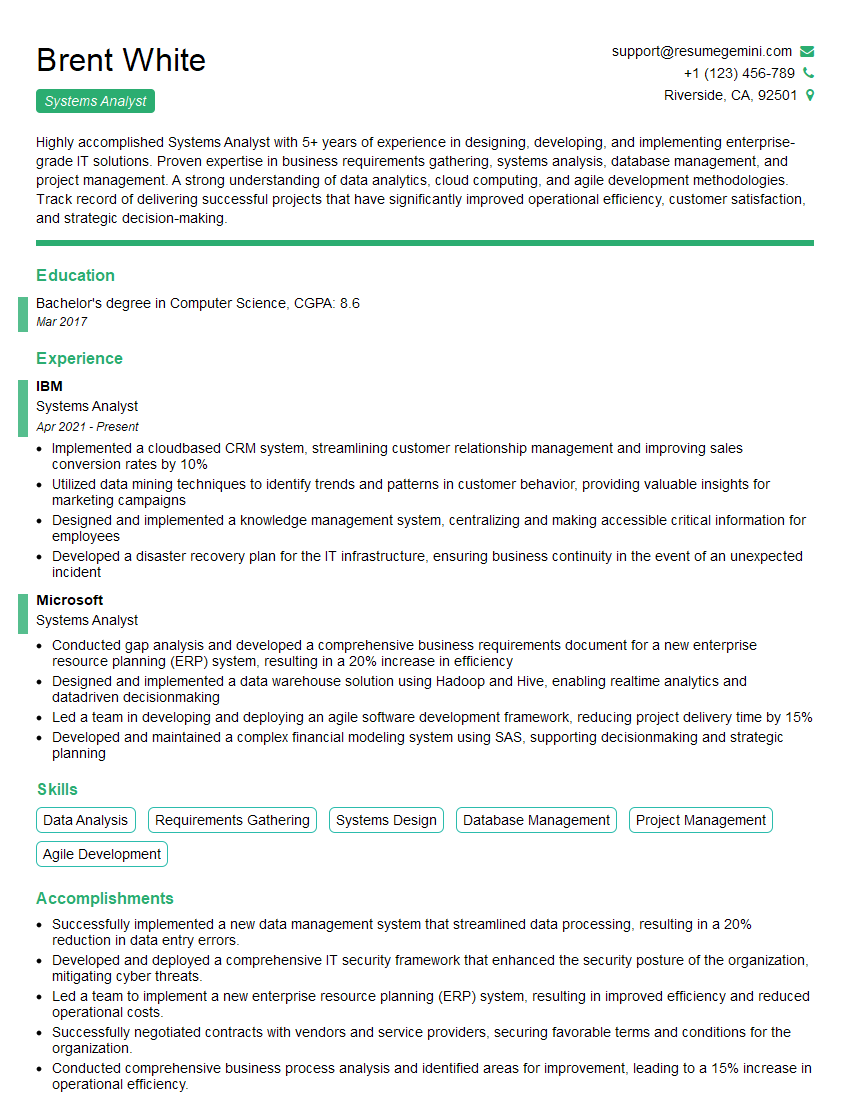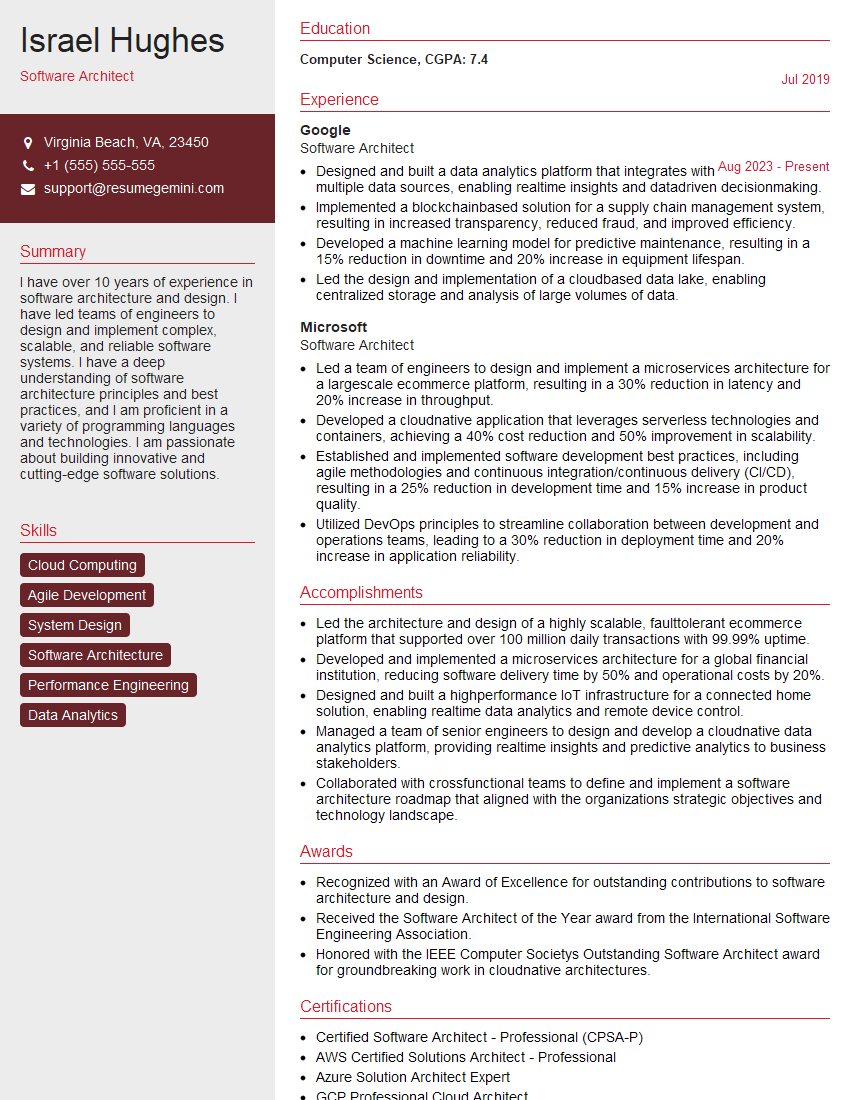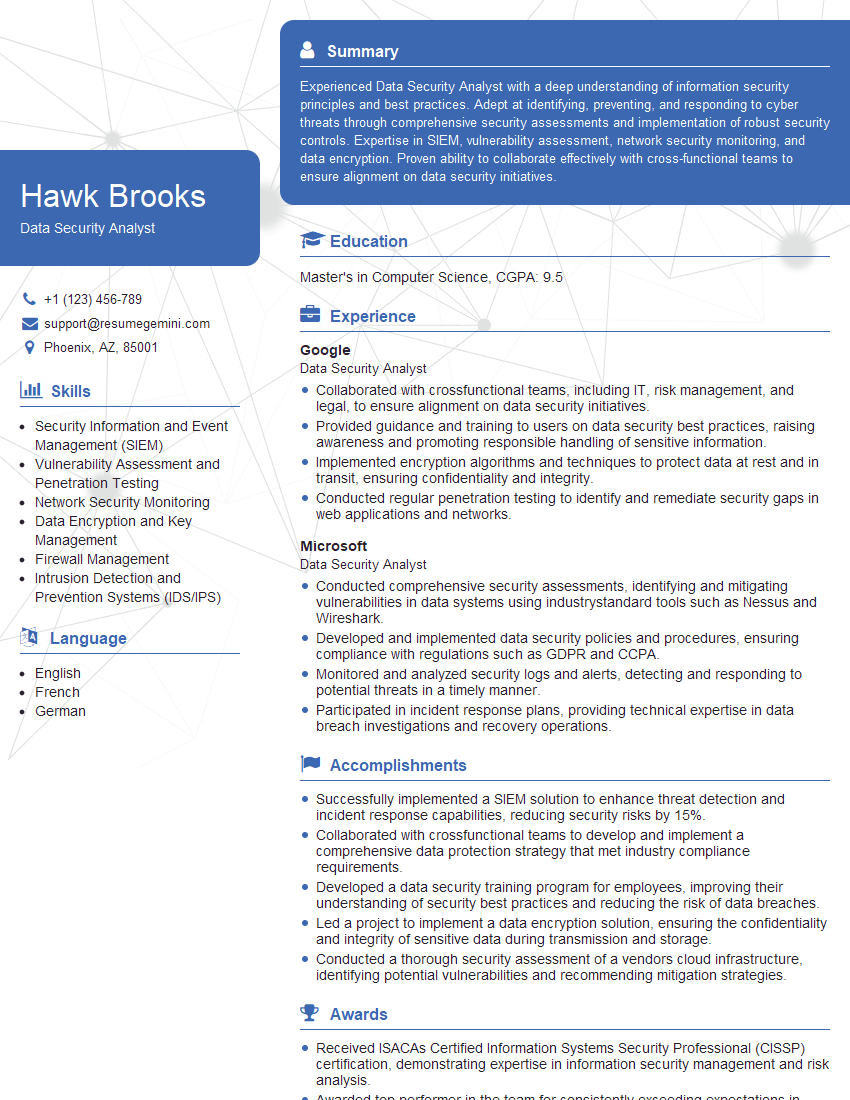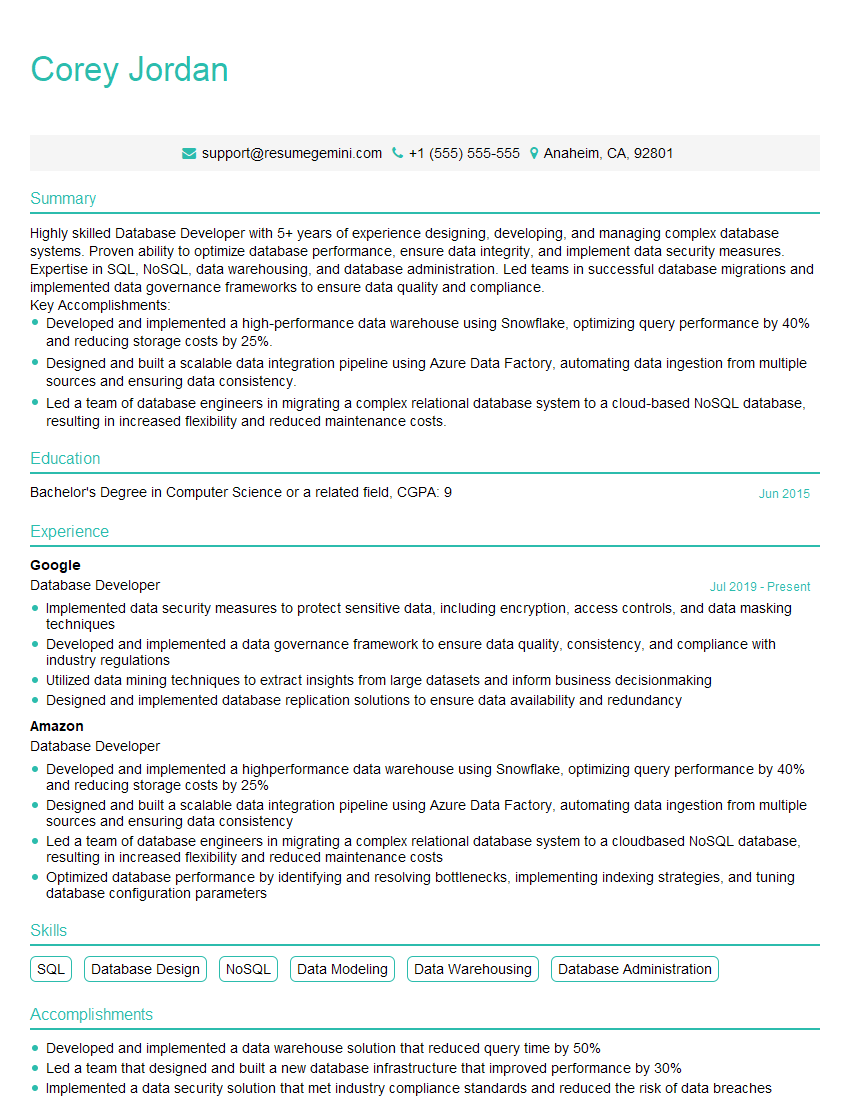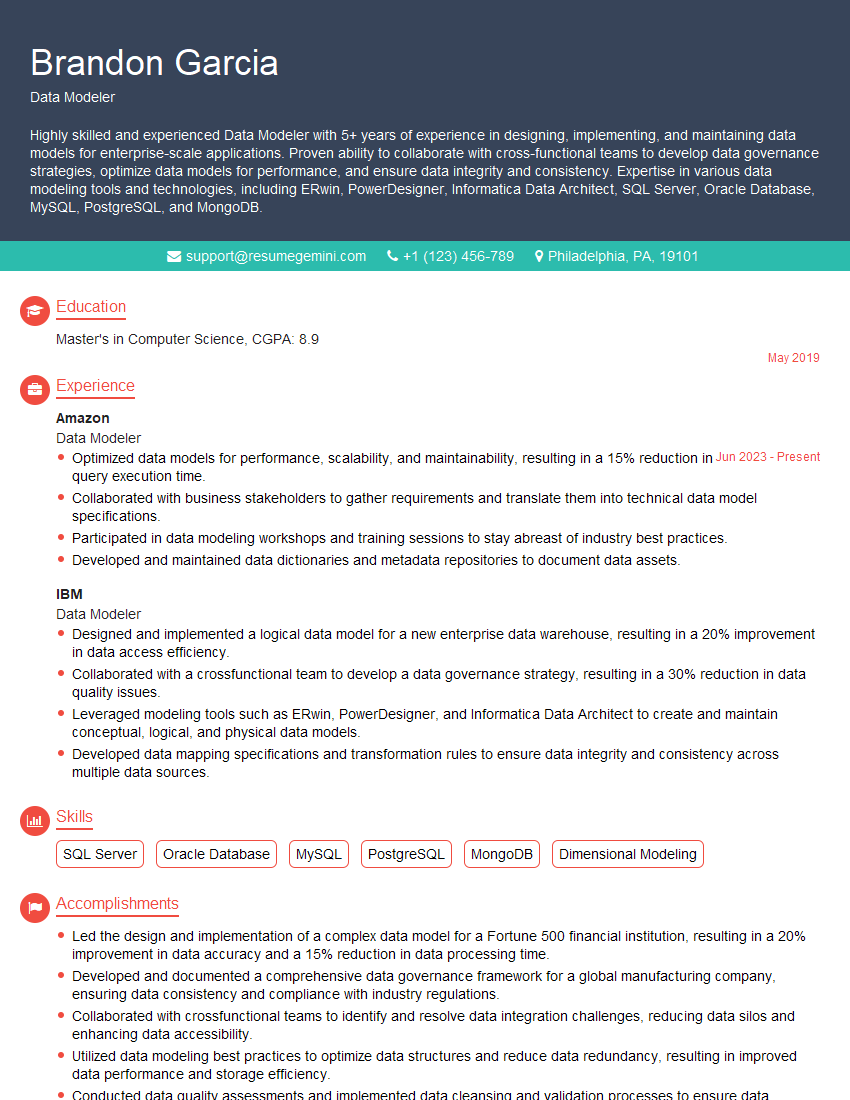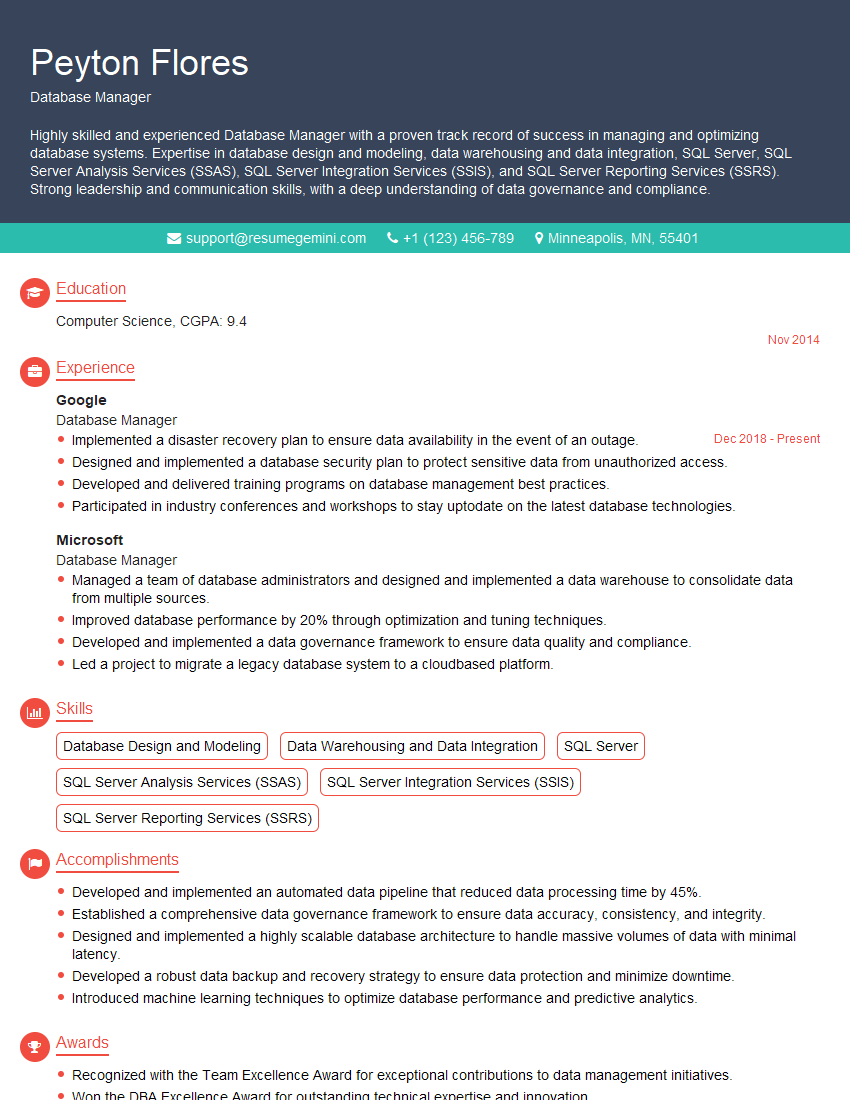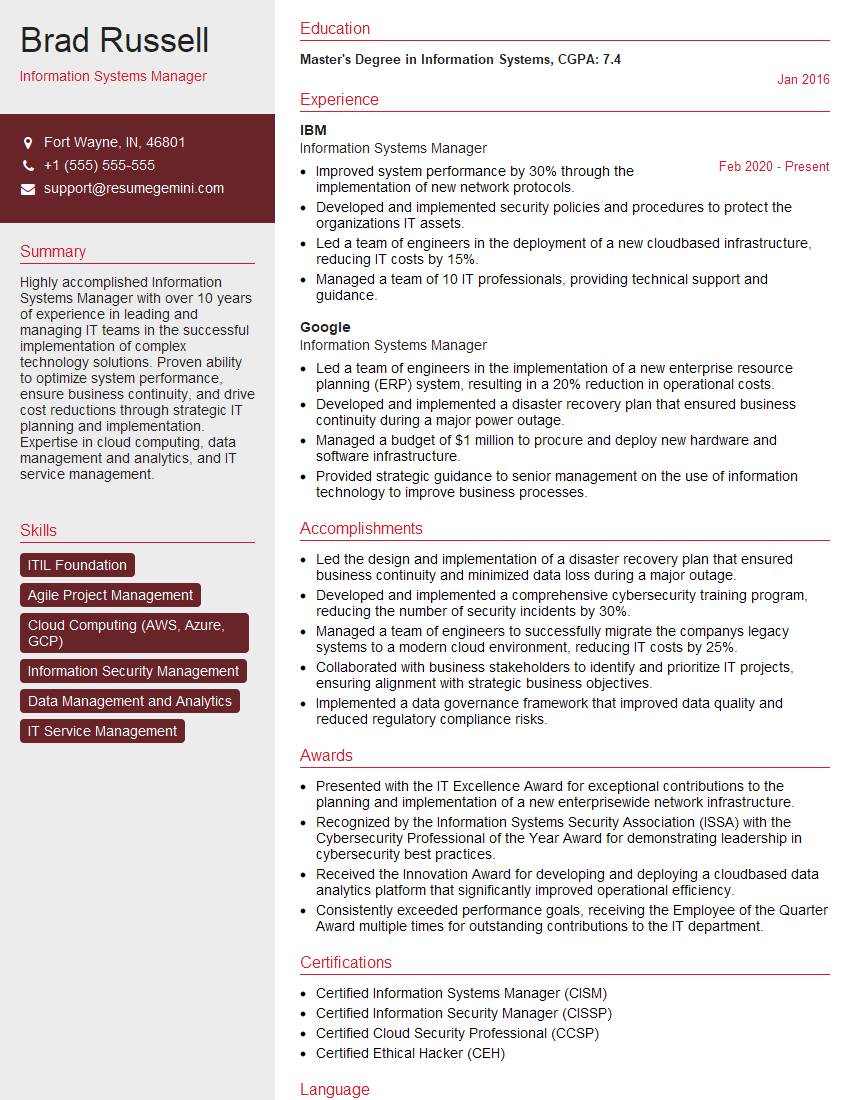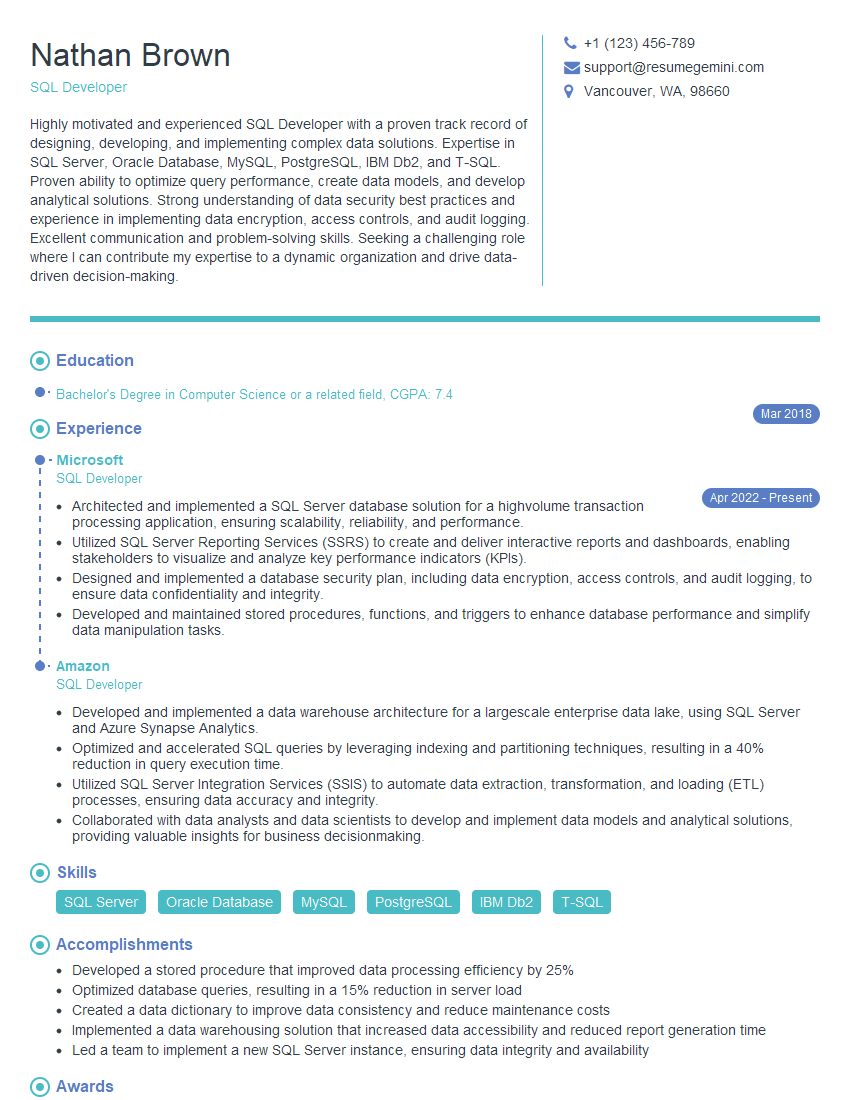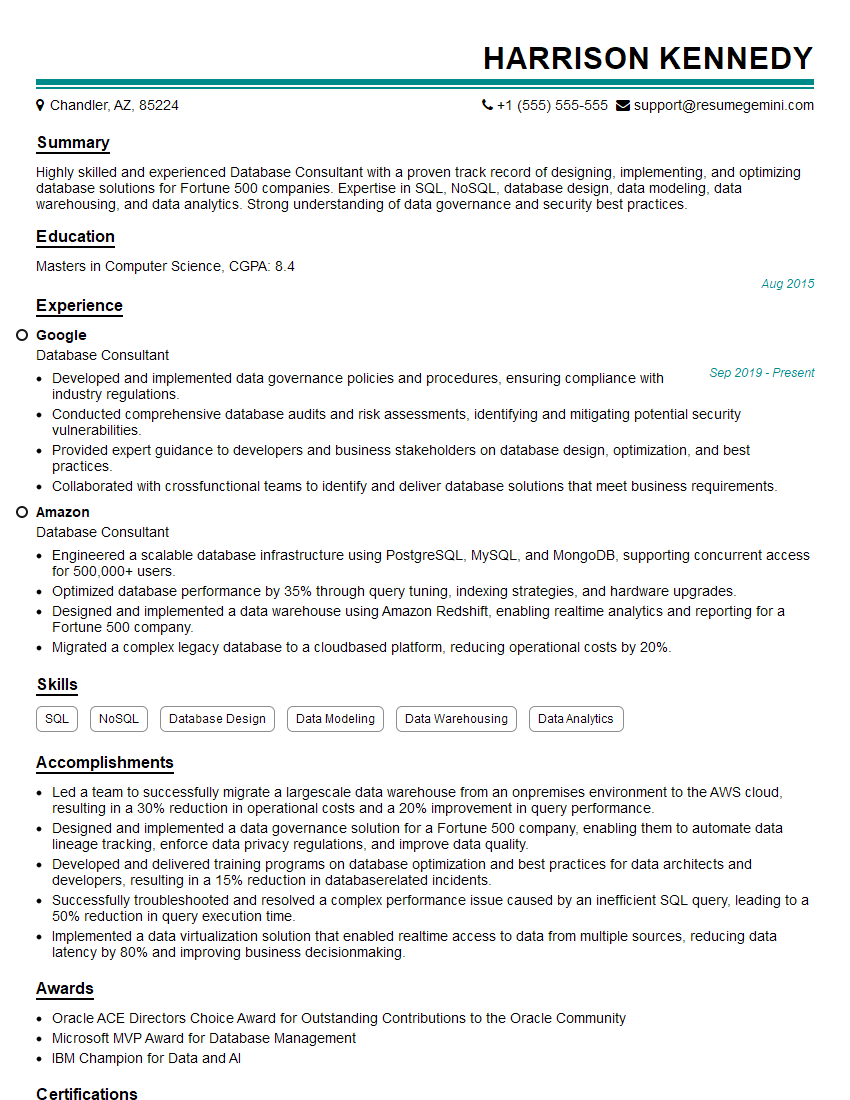Unlock your full potential by mastering the most common Use computer software and databases interview questions. This blog offers a deep dive into the critical topics, ensuring you’re not only prepared to answer but to excel. With these insights, you’ll approach your interview with clarity and confidence.
Questions Asked in Use computer software and databases Interview
Q 1. Explain the difference between SQL and NoSQL databases.
SQL and NoSQL databases represent distinct approaches to data management. SQL databases, also known as relational databases, organize data into tables with rows and columns, enforcing relationships between them. This structured approach ensures data integrity and consistency. Think of it like a well-organized spreadsheet where each sheet is a table and relationships are defined between them. Examples include MySQL, PostgreSQL, and Oracle.
NoSQL databases, on the other hand, are non-relational and offer more flexibility in data modeling. They don’t adhere to the rigid table structure of SQL, allowing for various data formats like key-value pairs, documents, or graphs. This makes them ideal for handling large volumes of unstructured or semi-structured data, such as social media posts or sensor data. Examples include MongoDB, Cassandra, and Redis.
The key difference lies in their data model and how they handle relationships. SQL excels in managing structured data with complex relationships, while NoSQL databases are better suited for scalability and flexibility when dealing with massive datasets or evolving data structures.
Q 2. What are the different types of database relationships?
Database relationships define how data in different tables are connected. There are several types:
- One-to-one: One record in a table is related to only one record in another table. For example, a person might have only one passport.
- One-to-many: One record in a table is related to multiple records in another table. A common example is a customer who can place multiple orders.
- Many-to-one: Multiple records in a table are related to one record in another table. This is the inverse of one-to-many; multiple orders belong to one customer.
- Many-to-many: Records in one table can be related to multiple records in another table, and vice-versa. For example, students can take multiple courses, and courses can have multiple students.
These relationships are implemented using foreign keys, which are columns in a table that refer to the primary key of another table. Properly defining relationships ensures data integrity and simplifies data retrieval.
Q 3. Describe normalization and its benefits.
Normalization is the process of organizing data in a database to reduce redundancy and improve data integrity. It involves dividing larger tables into smaller ones and defining relationships between them. Imagine a large spreadsheet with repeating information; normalization is like splitting it into smaller, more manageable spreadsheets, each with a specific purpose. This makes the database more efficient and easier to maintain.
The benefits include:
- Reduced data redundancy: Eliminates duplicate data, saving storage space and improving efficiency.
- Improved data integrity: Ensures consistency and accuracy by reducing the chance of data inconsistencies.
- Easier data modification: Changes only need to be made in one place, rather than multiple places, reducing errors and saving time.
- Better scalability: A normalized database is easier to scale and maintain as the amount of data grows.
Normalization is achieved through a series of normal forms (1NF, 2NF, 3NF, etc.), each addressing specific types of redundancy.
Q 4. What are indexes and why are they important?
Indexes in a database are special lookup tables that the database search engine can use to speed up data retrieval. Simply put, they’re like an index in a book—they help you quickly locate specific information without having to scan the entire book. Indexes are created on one or more columns of a table.
Their importance stems from significantly improving query performance, especially on large tables. Without indexes, the database has to perform a full table scan to find the required data, which can be very slow. Indexes allow the database to quickly locate the relevant data, leading to faster query execution and improved application responsiveness. However, adding too many indexes can slow down data insertion and updates, so careful consideration is needed.
Q 5. Explain ACID properties in the context of databases.
ACID properties are a set of four key characteristics that guarantee reliable database transactions. These are crucial for ensuring data integrity and consistency, especially in scenarios involving concurrent access and potential failures:
- Atomicity: A transaction is treated as a single, indivisible unit of work. Either all changes within the transaction are applied successfully, or none are. It’s like an all-or-nothing approach.
- Consistency: A transaction maintains the database’s integrity constraints. It ensures that the database remains in a valid state before and after the transaction.
- Isolation: Concurrent transactions are isolated from each other. Each transaction appears to be executed in isolation, preventing interference from other transactions.
- Durability: Once a transaction is committed, the changes are permanently saved and survive even system failures. The data is durable and persistent.
These properties ensure that database operations are reliable and predictable, even in complex and concurrent environments.
Q 6. How do you handle database transactions?
Handling database transactions involves using specific commands or APIs provided by the database system to manage the flow of operations. This typically involves the use of transaction blocks (BEGIN TRANSACTION, COMMIT, ROLLBACK) to group related operations. If all operations within a transaction succeed, it’s committed, making the changes permanent. If any operation fails, the entire transaction is rolled back, leaving the database unchanged. This ensures data integrity and consistency, even in the event of errors.
Example (SQL):
BEGIN TRANSACTION;
UPDATE accounts SET balance = balance - 100 WHERE id = 1;
UPDATE accounts SET balance = balance + 100 WHERE id = 2;
COMMIT;In this example, transferring money between two accounts is treated as a single transaction. If either update fails (e.g., insufficient funds), the entire transaction is rolled back, preventing inconsistencies in the account balances.
Q 7. What are some common SQL commands used for data manipulation?
Several common SQL commands are used for data manipulation. These commands allow you to interact with data stored within your relational database:
SELECT: Retrieves data from one or more tables.SELECT * FROM customers;retrieves all columns and rows from thecustomerstable.INSERT: Adds new data into a table.INSERT INTO customers (name, email) VALUES ('John Doe', '[email protected]');adds a new customer record.UPDATE: Modifies existing data in a table.UPDATE customers SET email = '[email protected]' WHERE id = 1;updates the email address of customer with ID 1.DELETE: Removes data from a table.DELETE FROM customers WHERE id = 1;deletes the customer with ID 1.
These commands, along with WHERE clauses for filtering data, are fundamental for querying, modifying, and managing data within a relational database system.
Q 8. How do you optimize SQL queries for performance?
Optimizing SQL queries for performance is crucial for any database-driven application. It involves a multifaceted approach focusing on query structure, indexing, and database design. Think of it like optimizing a highway system – you want smooth, efficient traffic flow.
- Use appropriate data types: Choosing the correct data type for each column minimizes storage space and improves query speed. For example, using
INTinstead ofVARCHARfor numerical IDs is significantly faster. - Avoid using
SELECT *: Only select the columns you actually need. Fetching unnecessary data slows down the query and consumes resources. Instead ofSELECT * FROM users;, useSELECT user_id, username, email FROM users; - Optimize
WHEREclauses: Use appropriate indexes (discussed in the next question) and avoid using functions within theWHEREclause if possible. For instance,WHERE LOWER(username) = 'john'is less efficient than having a lowercased username column and querying against that. - Use
EXISTSinstead ofCOUNT(*): When checking for the existence of records,EXISTSis generally more efficient thanCOUNT(*)as it stops searching once a match is found. - Analyze query execution plans: Most database systems provide tools to analyze query execution plans, showing how the database is processing the query. This allows you to identify bottlenecks and areas for improvement. This is your ‘traffic map’ showing slowdowns.
- Proper indexing (discussed in detail in the next question): This is paramount for query optimization.
- Avoid unnecessary joins: Too many joins can significantly impact performance. Carefully design your database schema to minimize joins.
- Batch operations: Instead of issuing many individual queries, group multiple operations into a single batch to reduce overhead.
For example, imagine querying a customer database for all customers in a specific city. A poorly optimized query could take minutes, while a well-optimized one, leveraging indexes and proper WHERE clause, could return results in milliseconds.
Q 9. What is database indexing and how does it improve query performance?
Database indexing is like creating an index for a book – it allows you to quickly find specific information without having to read the entire book. It dramatically improves query performance by creating a separate data structure that contains a subset of the table’s columns and pointers to the actual data rows.
When you execute a query with a WHERE clause that filters on an indexed column, the database system uses the index to quickly locate the relevant rows without having to scan the entire table. This dramatically reduces search time, particularly on large tables.
Different types of indexes exist:
- B-tree index: The most common type, suitable for range queries (e.g., finding all customers with ages between 25 and 35).
- Hash index: Optimized for equality searches (e.g., finding a customer with a specific ID).
- Full-text index: Used for searching text data (e.g., finding documents containing a specific keyword).
Imagine searching for a specific customer by their last name in a million-row table. Without an index on the last name, the database would have to scan the entire table. With an index, it can quickly find the relevant rows, making the search almost instantaneous.
CREATE INDEX idx_lastname ON customers (lastname);This SQL code creates a B-tree index named idx_lastname on the lastname column of the customers table.
Q 10. Explain different types of database joins (INNER, OUTER, LEFT, RIGHT).
Database joins combine rows from two or more tables based on a related column between them. Think of it like merging different spreadsheets based on common fields.
- INNER JOIN: Returns rows only when there is a match in both tables. It’s like finding the intersection of two sets.
- LEFT (OUTER) JOIN: Returns all rows from the left table (the one specified before
LEFT JOIN), even if there is no match in the right table. Null values are filled in for unmatched columns from the right table. - RIGHT (OUTER) JOIN: Similar to
LEFT JOIN, but it returns all rows from the right table, even if there is no match in the left table. - FULL (OUTER) JOIN: Returns all rows from both tables. If there’s a match, the corresponding row from both tables is included; if there isn’t a match, the columns from the missing table are filled with
NULLvalues.
Example (using SQL):
SELECT * FROM orders INNER JOIN customers ON orders.customer_id = customers.id;This query returns all orders and corresponding customer information where the customer_id matches between the orders and customers tables. A LEFT JOIN would also include orders even if the customer information was missing (perhaps due to data entry error).
Q 11. What are stored procedures and how are they used?
Stored procedures are pre-compiled SQL code blocks that can be stored in a database and reused multiple times. They act like reusable functions in programming languages, offering several advantages.
- Improved performance: Since they are pre-compiled, they execute faster than ad-hoc SQL queries.
- Reduced network traffic: Instead of sending multiple SQL statements across the network, a single call to a stored procedure suffices.
- Enhanced security: Stored procedures help enforce data integrity and security by controlling access to database operations.
- Code reusability: They promote modularity and reduce code duplication.
Example (pseudo-code):
Imagine a stored procedure UpdateCustomerInformation that takes customer ID, name, and address as input. This procedure would handle database updates, ensuring data validation and integrity. Calling this procedure is much more efficient and safer than writing a complex update query every time.
In a real-world scenario, a large e-commerce site might use stored procedures to handle order processing, user authentication, and inventory management. This improves performance, security, and maintainability of the application.
Q 12. How do you troubleshoot database performance issues?
Troubleshooting database performance issues requires a systematic approach. It’s like diagnosing a car problem – you need to identify the symptoms and investigate potential causes.
- Monitor performance metrics: Use database monitoring tools to track CPU usage, disk I/O, memory usage, and query execution times. These tools provide valuable clues about bottlenecks.
- Analyze slow queries: Identify queries that are consuming excessive resources and optimize them using the techniques discussed in question 1.
- Check for blocking issues: Determine if any processes are blocking others, preventing efficient access to data.
- Review indexing strategy: Ensure that appropriate indexes are in place to support frequently executed queries.
- Examine database configuration: Review database settings, such as buffer pool size and memory allocation, to ensure they are appropriately configured for the workload.
- Run database statistics: Up-to-date statistics help the query optimizer to generate efficient execution plans.
- Check for table fragmentation: Significant fragmentation can lead to slower data retrieval. If necessary, consider reorganizing or rebuilding tables.
- Consider hardware upgrades: If the database server is struggling to meet the demands of the application, an upgrade of CPU, RAM or storage might be necessary.
For example, I once identified a performance bottleneck by analyzing slow queries. I discovered a query missing crucial indexes which led to full table scans. Adding the appropriate indexes improved query performance by an order of magnitude.
Q 13. Describe your experience with ETL processes.
ETL (Extract, Transform, Load) processes are fundamental in data warehousing and business intelligence. They involve extracting data from various sources, transforming it into a consistent format, and loading it into a target data warehouse. It’s like taking ingredients from multiple recipes and combining them to make a delicious dish.
My experience includes designing and implementing ETL pipelines using various tools and technologies, including:
- Informatica PowerCenter: A leading ETL tool with a powerful graphical interface.
- Apache Kafka: For real-time data streaming and processing.
- Apache Spark: For large-scale data processing and transformation.
- SQL: Direct database manipulation is often a critical part of data transformations.
I’ve worked on projects involving data extraction from diverse sources, such as relational databases, flat files, APIs, and cloud storage platforms. The transformation processes often involve data cleaning, validation, standardization, and aggregation. Finally, the data is loaded into data warehouses, such as Snowflake or Amazon Redshift, optimized for analytical querying.
In one project, I improved an existing ETL pipeline’s performance by 40% by optimizing data transformation steps and utilizing parallel processing. This highlights the practical application of understanding data processing efficiency within ETL.
Q 14. Explain your experience with data warehousing.
Data warehousing is the process of consolidating data from various sources into a central repository designed for analytical processing. It’s like creating a central library of information that can be accessed for insights and decision-making. It’s distinct from operational databases which are designed for transactional purposes.
My experience spans the entire data warehousing lifecycle, from requirements gathering and design to implementation, testing, and maintenance. This includes:
- Designing dimensional models: Creating star schemas or snowflake schemas to organize data for efficient querying.
- Choosing appropriate database technologies: Selecting data warehouse platforms based on specific needs (Scalability, cost, etc.)
- Implementing ETL processes: Building and maintaining ETL pipelines to populate the data warehouse.
- Performance tuning: Optimizing query performance and ensuring scalability of the data warehouse.
- Data governance and security: Implementing appropriate security and access controls to protect sensitive data.
In one project, I designed and implemented a data warehouse for a financial institution. This involved designing the dimensional model, implementing ETL processes to consolidate data from multiple operational databases, and optimizing the warehouse for high-performance analytical queries used for fraud detection and risk management.
Q 15. What are your preferred tools for data visualization?
My preferred tools for data visualization depend heavily on the nature of the data and the desired outcome. For quick exploratory analysis and interactive dashboards, I frequently use Tableau and Power BI. They offer intuitive drag-and-drop interfaces, making it easy to create compelling visualizations from diverse data sources. For more customized and publication-ready visuals, particularly when dealing with complex statistical models or large datasets requiring optimized performance, I leverage Python libraries such as Matplotlib, Seaborn, and Plotly. Plotly, in particular, excels at creating interactive web-based visualizations suitable for sharing and embedding in reports or presentations.
For example, when analyzing customer churn data, I might use Tableau to quickly create a geographic heatmap showing churn rates across different regions. Then, using Python and Seaborn, I could delve deeper by creating a violin plot to visualize the distribution of customer tenure before churn for various demographics. The choice of tool always hinges on the specific analytical task and the desired level of customization.
Career Expert Tips:
- Ace those interviews! Prepare effectively by reviewing the Top 50 Most Common Interview Questions on ResumeGemini.
- Navigate your job search with confidence! Explore a wide range of Career Tips on ResumeGemini. Learn about common challenges and recommendations to overcome them.
- Craft the perfect resume! Master the Art of Resume Writing with ResumeGemini’s guide. Showcase your unique qualifications and achievements effectively.
- Don’t miss out on holiday savings! Build your dream resume with ResumeGemini’s ATS optimized templates.
Q 16. How do you ensure data integrity and security?
Ensuring data integrity and security is paramount. My approach is multifaceted and involves several key strategies. Firstly, I rigorously validate data at every stage of the pipeline, from ingestion to analysis. This includes implementing data quality checks to identify and correct inconsistencies, missing values, and outliers. For example, I might use regular expressions to validate email addresses or check for data type mismatches. Secondly, I employ robust access control mechanisms, limiting access to sensitive data based on the principle of least privilege. This often involves integrating with existing security systems and utilizing role-based access control (RBAC).
Furthermore, I encrypt data both in transit and at rest. This protects the data from unauthorized access even if a breach occurs. Data masking and anonymization techniques are also utilized when appropriate, reducing the risk associated with sensitive personally identifiable information (PII). Regular backups and disaster recovery planning are also crucial components of my strategy, ensuring business continuity in the event of data loss or system failure.
Q 17. What is your experience with cloud-based databases (e.g., AWS RDS, Azure SQL Database)?
I have extensive experience with cloud-based databases, particularly AWS RDS and Azure SQL Database. I’ve managed and optimized databases on both platforms, handling tasks such as database provisioning, configuration, performance tuning, and security management. With AWS RDS, I’ve worked with various database engines, including MySQL, PostgreSQL, and Oracle, leveraging features such as read replicas and automated backups for enhanced scalability and resilience. Similarly, with Azure SQL Database, I’ve utilized features like elastic pools and failover groups for high availability and performance optimization.
For instance, in a recent project involving a high-traffic e-commerce website, I migrated the database from an on-premises solution to AWS RDS for PostgreSQL. This allowed us to scale the database resources dynamically to meet fluctuating demands, improving performance and reducing operational costs. We implemented read replicas to distribute read traffic and decrease latency for users accessing product information.
Q 18. Explain your experience with data modeling.
Data modeling is a crucial part of my workflow. I am proficient in various modeling techniques, including Entity-Relationship Diagrams (ERDs) and dimensional modeling. I start by thoroughly understanding the business requirements and identifying key entities and their attributes. I then define relationships between entities, ensuring data consistency and integrity. For ERDs, I often use tools like Lucidchart or draw.io, and for dimensional modeling, I employ star schemas or snowflake schemas depending on the analytical needs. The choice of modeling technique is determined by the intended use of the data – operational needs versus analytical reporting.
For example, in a project involving a customer relationship management (CRM) system, I created an ERD to model customers, orders, products, and sales representatives. This model defined the relationships between these entities, ensuring that data related to a customer’s orders and interactions with sales representatives could be easily accessed and analyzed. This robust model prevented data redundancy and enabled efficient data retrieval.
Q 19. Describe your experience with different database management systems (DBMS).
My experience spans several DBMS, including relational databases like MySQL, PostgreSQL, Oracle, and SQL Server, as well as NoSQL databases such as MongoDB and Cassandra. Each database system has its strengths and weaknesses, and my choice depends on the specific needs of the project. For example, relational databases are well-suited for structured data requiring ACID properties (Atomicity, Consistency, Isolation, Durability), while NoSQL databases excel at handling large volumes of unstructured or semi-structured data with high scalability requirements.
I’m comfortable writing SQL queries across various dialects, optimizing query performance using indexes and stored procedures. With NoSQL databases, I’m experienced in designing schema-less data models and utilizing appropriate indexing strategies for efficient data retrieval. My experience extends beyond just querying; I’m also proficient in database administration tasks like user management, backup and recovery, and performance monitoring.
Q 20. How do you handle large datasets?
Handling large datasets requires a strategic approach combining efficient data storage, processing, and querying techniques. I leverage distributed computing frameworks like Apache Spark and Hadoop to process and analyze data that exceeds the capacity of a single machine. These frameworks allow for parallel processing, significantly reducing processing time for large datasets. Additionally, I employ techniques like data partitioning and sampling to manage data size effectively. Data warehousing techniques, such as creating summary tables or materialized views, can also be beneficial for improving query performance against large analytical datasets.
For example, when analyzing terabytes of website clickstream data, I’ve used Spark to perform aggregations and transformations on the data in parallel across a cluster of machines. This allowed for efficient calculation of metrics such as website traffic patterns and user engagement.
Q 21. What is your experience with data mining techniques?
I have experience applying various data mining techniques, including association rule mining, clustering, and classification. Association rule mining, for example, helps identify relationships between items in transactional data. I’ve used the Apriori algorithm to uncover interesting associations between products purchased together in an e-commerce setting. Clustering techniques like k-means and DBSCAN are frequently employed to group similar data points based on their characteristics. This is useful in customer segmentation or anomaly detection. Classification algorithms such as decision trees, support vector machines (SVMs), and logistic regression are used to predict categorical outcomes. For example, predicting customer churn based on their historical behavior.
In a recent project, I employed a combination of clustering and classification techniques to identify high-value customers and predict their future purchasing behavior. This analysis informed targeted marketing campaigns, improving customer retention and increasing sales.
Q 22. How do you approach designing a database schema?
Designing a database schema is like creating the blueprint for a house. You need to carefully plan how you’ll organize all the information (rooms) and how those different parts relate to each other (hallways). It’s a crucial step, as a poorly designed schema can lead to performance issues and data inconsistencies down the line. My approach involves several key steps:
- Requirements Gathering: I start by thoroughly understanding the needs of the application or business. This involves talking to stakeholders, analyzing existing data, and documenting all the necessary entities, their attributes, and their relationships.
- Entity-Relationship Diagram (ERD): I create an ERD to visually represent the data model. This helps me identify entities (e.g., Customers, Products, Orders), attributes (e.g., CustomerName, ProductPrice, OrderDate), and the relationships between them (e.g., a Customer can place many Orders, an Order contains many Products). I use tools like Lucidchart or draw.io to create and manage these diagrams.
- Normalization: To minimize data redundancy and ensure data integrity, I apply database normalization techniques. This involves breaking down larger tables into smaller, more manageable ones, reducing data duplication and improving efficiency. For example, instead of having a single table with customer information and their order history, I might separate them into a Customer table and an Order table with a foreign key linking them.
- Data Type Selection: Choosing the correct data types (e.g., INT, VARCHAR, DATE, BOOLEAN) is crucial for efficiency and data integrity. I ensure each attribute has the most appropriate data type based on its expected values and usage.
- Indexing: I carefully plan indexes to optimize query performance. Indexes are like the index in a book, allowing the database to quickly locate specific data without having to scan the entire table.
- Review and Iteration: Once the schema is designed, I review it with stakeholders to ensure it accurately reflects the requirements. This often involves iterations and adjustments based on feedback.
For instance, in a project involving an e-commerce platform, I designed a schema with tables for Customers, Products, Orders, and OrderItems, ensuring proper relationships and normalization to effectively manage product catalogs, customer accounts, and order processing.
Q 23. Explain your experience with data cleaning and transformation.
Data cleaning and transformation is a critical step in any data analysis project. It’s like spring cleaning your house – you need to get rid of the clutter and organize things before you can use the space effectively. My experience involves various techniques:
- Handling Missing Values: I use various methods depending on the context. This can include imputation (filling in missing values with estimated values based on other data), removal of rows or columns with excessive missing data, or using algorithms that can handle missing data directly.
- Data Type Conversion: I often need to convert data from one type to another (e.g., converting strings to numbers or dates). This might involve using regular expressions or built-in functions provided by programming languages like Python or SQL.
- Outlier Detection and Treatment: Identifying and handling outliers (extreme values that might skew results) is vital. Techniques include using box plots, z-scores, or interquartile range (IQR) to identify outliers, and then either removing them or transforming them (e.g., using logarithmic transformation).
- Data Standardization and Normalization: To make data comparable across different sources or variables, I apply standardization (e.g., z-score normalization) or other normalization techniques to bring them to a common scale.
- Data Deduplication: Identifying and removing duplicate records is crucial for data accuracy. This can involve using SQL queries or specialized tools to detect and handle duplicates.
For example, in a recent project, I cleaned a dataset containing customer demographics and purchase history. I used Python’s pandas library to handle missing values (using imputation for some fields and removal for others), standardized some numerical features, and used SQL to deduplicate records based on unique customer IDs.
Q 24. How do you handle missing or incomplete data?
Missing or incomplete data is a common challenge in data analysis. It’s like having a puzzle with missing pieces; you can’t get the complete picture without addressing those gaps. My approach involves a combination of strategies:
- Understanding the Cause: I begin by investigating why the data is missing. Is it due to random errors, systematic biases, or intentional omissions? This helps me choose the most appropriate imputation strategy.
- Imputation Techniques: Depending on the nature of the data and the missingness mechanism, I may use various imputation techniques:
- Mean/Median/Mode Imputation: Replacing missing values with the mean, median, or mode of the available data (simple but can distort distributions).
- Regression Imputation: Predicting missing values using a regression model based on other variables.
- K-Nearest Neighbors (KNN) Imputation: Imputing missing values based on the values of similar data points.
- Multiple Imputation: Creating multiple imputed datasets to account for uncertainty in the imputation process.
- Deletion Methods: If the amount of missing data is small and random, I might consider deleting the affected rows or columns (listwise or pairwise deletion). However, this can lead to significant information loss if not carefully considered.
- Model Selection: Some machine learning algorithms (like XGBoost or random forests) can handle missing values directly without the need for imputation. Choosing such algorithms can simplify the process.
For example, if I have missing values in a customer’s age, and I have other relevant information like their purchase history, I might use regression imputation to predict their age based on the patterns observed in the data. If the amount of missing data is substantial and potentially biased, I may opt for more sophisticated techniques like multiple imputation.
Q 25. Describe your experience with data governance.
Data governance is the set of processes, policies, and standards that ensure data is managed effectively throughout its lifecycle. It’s like the rules and regulations of a city that ensure everything runs smoothly. My experience includes:
- Data Quality Management: Defining and implementing processes to maintain data accuracy, completeness, consistency, and timeliness. This includes establishing data quality rules and metrics.
- Data Security and Access Control: Implementing security measures to protect sensitive data and control access based on roles and responsibilities. This involves adhering to data privacy regulations like GDPR or CCPA.
- Metadata Management: Creating and managing metadata (data about data) to ensure data is properly documented and understood. This is essential for tracking data lineage and ensuring data discoverability.
- Data Dictionary Creation and Maintenance: Developing and maintaining a data dictionary that defines all data elements, their meaning, and their relationships. This acts as a central repository of information about the data.
- Data Standards and Policies: Defining and enforcing standards for data naming conventions, data formats, and data quality. This ensures consistency and interoperability across different systems.
In a past role, I helped implement a data governance framework for a large financial institution. This involved creating a data quality dashboard to track key metrics, defining data access policies, and establishing a process for managing metadata. The result was improved data quality, enhanced security, and greater compliance with regulatory requirements.
Q 26. What is your experience with version control systems for database code?
Version control systems are essential for managing changes to database code, just as they are for software code. It’s like having a detailed history of every change made to a document, allowing you to revert to previous versions if necessary. My experience primarily involves using Git for database schema and stored procedure management.
- Schema Versioning: I use Git to track changes to database schema files (e.g., SQL scripts). This allows me to easily review changes, roll back to previous versions, and collaborate with other developers.
- Stored Procedure Versioning: Similar to schema versioning, I track changes to stored procedures and other database objects. This ensures that I can manage different versions and revert if needed.
- Branching and Merging: Using Git’s branching capabilities, I can work on multiple features or bug fixes concurrently without affecting the main codebase. This is particularly helpful in collaborative environments.
- Continuous Integration/Continuous Deployment (CI/CD): I’ve integrated Git with CI/CD pipelines to automate the process of deploying database changes to different environments (development, testing, production). This ensures consistency and reduces manual errors.
For example, I might use a tool like Liquibase or Flyway in conjunction with Git to manage database migrations. These tools help to automate the process of applying changes to the database schema in a controlled and repeatable manner.
Q 27. Explain your experience with database replication and high availability.
Database replication and high availability are critical for ensuring data redundancy and minimizing downtime. It’s like having a backup copy of your important documents – if one copy is lost or damaged, you still have another. My experience encompasses various approaches:
- Replication Techniques: I’m familiar with various replication techniques, including synchronous and asynchronous replication, master-slave replication, and multi-master replication. The choice of technique depends on factors such as performance requirements, data consistency needs, and the complexity of the environment.
- High Availability Architectures: I’ve worked with high availability architectures such as clustered databases (e.g., Oracle RAC, SQL Server AlwaysOn) and read replicas to ensure continuous database availability even in case of hardware failures or other outages. This also improves read performance by distributing read operations across multiple database instances.
- Failover Mechanisms: I understand how to configure failover mechanisms to automatically switch to a backup database instance in case of a primary database failure. This minimizes downtime and ensures business continuity.
- Disaster Recovery Planning: I’m experienced in developing and implementing disaster recovery plans that encompass database replication, backups, and procedures for restoring the database in case of a major disaster.
For instance, in a project involving a large online banking system, I implemented a multi-master replication strategy to provide high availability and ensure data consistency across multiple geographic locations. This involved careful configuration of replication settings, failover mechanisms, and regular testing to ensure the system could withstand potential outages.
Key Topics to Learn for Use Computer Software and Databases Interview
- Database Management Systems (DBMS): Understanding relational databases (SQL), NoSQL databases, data modeling, and database design principles. Consider practical examples of schema design and query optimization.
- SQL Proficiency: Mastering SQL queries (SELECT, INSERT, UPDATE, DELETE), joins, subqueries, and aggregate functions. Practice writing efficient and optimized queries for data retrieval and manipulation. Think about how you’d handle large datasets.
- Data Analysis and Interpretation: Learn to extract meaningful insights from data using various techniques. Practice interpreting query results and presenting findings clearly and concisely. Consider how you’d identify trends and anomalies.
- Data Cleaning and Preprocessing: Understanding techniques for handling missing data, outliers, and inconsistencies. This is crucial for ensuring data accuracy and reliability for analysis and reporting.
- Software Proficiency (relevant to the role): Demonstrate expertise in the specific software applications mentioned in the job description. This could include spreadsheet software (Excel, Google Sheets), data visualization tools (Tableau, Power BI), or programming languages (Python, R) used for data analysis.
- Data Security and Privacy: Understanding data security best practices and relevant regulations (e.g., GDPR). Be prepared to discuss how you would handle sensitive data responsibly.
- Problem-solving and Analytical Skills: Showcase your ability to approach data-related problems systematically, break them down into smaller components, and develop effective solutions. Prepare examples demonstrating your analytical thinking.
Next Steps
Mastering the use of computer software and databases is crucial for career advancement in today’s data-driven world. Strong skills in this area open doors to exciting opportunities and higher earning potential. To maximize your job prospects, focus on creating an ATS-friendly resume that highlights your relevant skills and experience. ResumeGemini is a trusted resource for building professional, impactful resumes. Use ResumeGemini to craft a compelling resume that showcases your abilities; examples of resumes tailored to “Use computer software and databases” roles are available to guide you.
Explore more articles
Users Rating of Our Blogs
Share Your Experience
We value your feedback! Please rate our content and share your thoughts (optional).
What Readers Say About Our Blog
Live Rent Free!
https://bit.ly/LiveRentFREE
Interesting Article, I liked the depth of knowledge you’ve shared.
Helpful, thanks for sharing.
Hi, I represent a social media marketing agency and liked your blog
Hi, I represent an SEO company that specialises in getting you AI citations and higher rankings on Google. I’d like to offer you a 100% free SEO audit for your website. Would you be interested?



